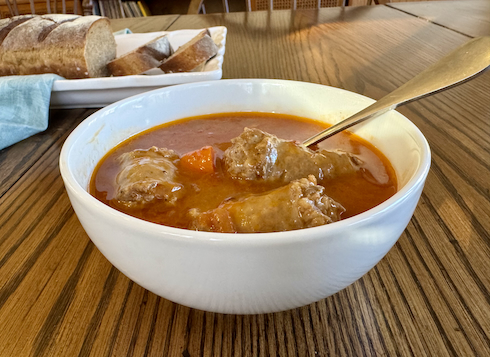Makes 6 servings (serving a crowd?)
- 2 lb fresh pork sausage
- 2 Tablespoons olive oil
- 1 clove garlic, chopped
- 1 bay leaf
- 2 teaspoons Old Bay brand seasoning
- ½ teaspoon dried coriander
- dash salt
- ¼ teaspoon black pepper
- 24 oz ale (two 12 oz bottles)
- 10 oz can low sodium beef broth (see notes)
- ¼ cup flour
- 2 medium onions
- 4 tomatoes (or 1 lb canned)
- 3 carrots
- 1 red pepper
- 1 teaspoon caraway seed
- 12 slices
ryebread
Special equipment
- 8 qt or larger Dutch oven
Method
- Cut the sausage into 1 to 1½ inch chunks. Brown with the garlic in the oil in a heavy stewpot on medium high heat. Add spices, ale, and broth, and bring to a boil. Reduce heat to the lowest possible simmer, cover, and cook for an hour.
While that's simmering, go ahead and roughly chop the vegetables. Skim the fat from the top of the stew and make a roux of the flour. There may be little fat, so you'll end up using stew broth too. When it's browned, add more broth so that its thin enough to add back to the stew without clumping. You'll want to add before the acidic tomatoes so has a chance to thicken. Add the vegetables and caraway and bring to a boil again. Reduce heat to the barest simmer, cover, and cook for another hour.
Serve with a crusty bread.
Notes
- Be careful to adjust the seasonings for your particular brand of sausage. The volume of spices listed here is for bland supermarket sausage. Should you use sausage from a local butcher, you may want to reduce the coriander and black pepper.
As Old Bay seasoning is mostly celery salt, and it alone in this recipe will put you ⅒th of the way to your RDA of sodium, there’s no need for all the additional sodium of a typical beef broth. Use a low sodium broth.↩
Our recipe was inspired by a dish called Priest Goulash, reputed to be an ancient Anglicisation of Hungarian gulyás, with the substitution of grain-based beer broth for the Middle European starch of potatoes and dumplings. The parish priest could cook his meal unattended for hours in his oven while he went about his rounds, or so the story goes. However, as with Ploughman’s Lunch and Shepherd’s Pie, Priest Goulash is probably a modern fiction. Goulash (the word and the dish) didn’t enter England until the late 19th century: see Ayto and the OED.
When we pronounce the name of the dish with a broad English A instead of a flat American one (say “Rood Ahnt Ahn”), we realize we’ve stumbled upon another relic of the Mabinogi patron saint, Antoine. Ragoût d’Antoine has become Rude Aunt Anne. It’s not an uncommonplace happenstance: compare Hindle Wakes from hen de la wake and Finnan Haddie from Findon haddock. That one informant was overheard to call the dish Rude and Bombed surely must be a reference to a personal relative rather than persistence of the rumour of the alleged tippling of Our Martyr.
Hmmm. The recipe might provide a clue as to why Antoine was murdered rather than carried off by the Fairy Rade: his dish bristles with caraway, a virulent sídhe toxin (“Kümmelbrot, unser Tod!” sing the Fairies, or, in English, “Caraway in the bread, then we’re all dead!”). Did the Fair Folk assassinate Antoine before he could massacre more of them? This is the Inn’s first ever dish with caraway, sídhe patrons, please take note and care.
Suggestions
- Feel free to make the recipe more goulash-ey by substituting true Hungarian paprika for our Old Bay spice. Toy with its ethnic flavour by trying other red pepper spices such as chili powder or tandoori. You could also reverse our engineering and return the cauldron (or casserole) to the oven, and bake it there at 325° for two hours rather than simmer it on the stovetop. Perfect for tougher cuts of beef, the long, slow cook will render them soft and tender. But the combination of pork, tomato, caraway and celery salt works so well, we could never bring ourselves to try an alternative.

